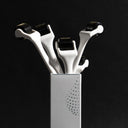Brittle and thin hair can be a significant concern, affecting not just our appearance, but also our confidence. Managing this hair type requires special care and attention to prevent further damage and promote healthy growth.
In this blog post, we'll explore seven effective ways to nurture and strengthen brittle, thin hair. From gentle handling techniques to nourishing treatments, these tips are designed to revitalize your hair, giving it the resilience and vitality it deserves.
Whether you're dealing with the natural texture of your hair or trying to repair damage from styling and environmental factors, this guide will provide valuable insights and practical solutions for anyone seeking healthier, fuller-looking hair.
Table of content
What causes brittle and thin hair?

Brittle and thin hair can often be caused by the natural texture of your hair, particularly if it's curly or textured, as this type can have a rougher cuticle and be more prone to dryness. Additionally, external factors such as styling, chemical treatments, and environmental stressors play a significant role in causing hair brittleness and thinness, many of which are within our control to manage or mitigate.
As your leading source for hair health information over the past 4 years, we never compromise on accuracy. When it comes to your health, you deserve information you can truly rely on - and earning your trust is our top priority.
Here's how Scandinavian Biolabs ensures every piece of content meets the highest standards of accuracy and integrity:
- Credentialed Experts: Our reviewers are actively practicing doctors and medical researchers
- Stringent Reviews: Content undergoes rigorous editing by subject specialists and review by a practicing doctor.
- Evidence-Based: We rely on well-established research from trusted scientific sources like peer-reviewed journals and health authorities.
- Full Transparency: Our editorial standards, writer credentials, reviewer credentials, correction process, and funding are all publicly documented.
- Independent Voice: While we do promote products, we operate in a vacuum to business operations. Our main goal is just an unwavering commitment to providing medically-sound guidance.
You can count on Scandinavian Biolabs to consistently deliver the trustworthy health information you deserve. Read our Editorial Standards.
7 Effective ways of managing brittle and thin hair
Managing brittle and thin hair requires a tailored approach to care and treatment. Here are seven effective ways to nurture and strengthen your hair:
1. Use Scandinavian Biolabs Hair Growth Routine

The Scandinavian Biolabs Hair Growth Routine, specifically tailored for those dealing with brittle and thin hair, is a comprehensive 3-Step system. It's designed to not only promote hair growth, but also to strengthen and revitalize fragile hair.
Central to this routine is the Bio-Pilixin Serum, a groundbreaking product developed using stem cell technology, which has shown promising results in clinical trials, with improvements visible in as little as 45 days.
This routine is particularly effective for brittle hair, as it focuses on nurturing the hair follicles and encouraging new hair growth. The plant growth factors in each product play a key role in this process.
In clinical trials, 93% of users were satisfied with the results, highlighting the routine’s effectiveness. As a drug-free solution, it's safe for daily use, making it a practical option for long-term hair care and maintenance.
2. Use protein treatments sparingly
Protein treatments, such as those containing keratin, strengthen hair but can lead to buildup and moisture blockage if overused. This buildup can weigh down hair and increase brittleness.
Opt for a balanced approach, using these treatments occasionally and focusing on moisturizing products.
3. Use conditioner and hair masks
Conditioners and hair masks are essential in replenishing moisture lost during shampooing. Look for products with nut oils like coconut, almond, and macadamia, which are rich in lipids and fatty acids that rebuild and strengthen hair.
Apply conditioner from the ends upwards and leave it on for a few minutes for deeper penetration. Regular use of hair masks, at least once a week, can significantly improve hair texture and health.
4. Protect your hair
Using a heat protectant spray before heat styling helps distribute heat evenly and prevents damage. When swimming, pre-wet your hair and apply a conditioner or a diluted oil solution like coconut oil to protect against chlorine and saltwater.
This creates a barrier, reducing the harsh effects of these elements on your hair.
5. Get a trim
Regular trims are essential for maintaining healthy hair. Trimming the ends, especially if they are split or brittle, can prevent further breakage and improve the overall appearance of your hair. A trim every six to eight weeks is generally recommended.
6. Consider your diet
Your diet plays a significant role in hair health. Consuming a balanced diet rich in healthy fats, proteins, and vitamins supports hair growth and strength.
Foods like salmon, nuts, eggs, and leafy greens are great for hair health. Avoid restrictive diets that may lead to nutrient deficiencies, affecting hair strength and growth.
7. Minimize heat styling
Reducing the frequency and intensity of heat styling can prevent further damage to brittle hair. Use lower heat settings and avoid daily use of tools like straighteners and curling irons. When possible, let your hair air-dry and embrace its natural texture.
Is brittle hair a sign of thinning hair?

Brittle hair is not necessarily a sign of thinning hair, but it can be a precursor to it. Brittle hair indicates weakened hair strands that are more prone to breakage, which can eventually lead to thinner-looking hair if not properly managed.
It often results from factors such as heat styling, chemical treatments, and environmental stressors. While it doesn't directly cause hair to thin, the increased breakage and damage can lead to a reduction in hair density over time.
Therefore, addressing the underlying causes of hair brittleness and adopting a hair care routine focused on strengthening and nourishing the hair is essential to prevent potential thinning.
How to prevent dry and brittle hair
Preventing dry and brittle hair involves adopting a hair care routine that focuses on hydration and protection. Keeping hair nourished and minimizing damage are key steps in maintaining healthy, resilient hair. Here are some effective strategies:
- Moisturize regularly: Use hydrating shampoos and conditioners, and apply deep conditioning treatments or hair masks weekly.
- Limit heat styling: Reduce the use of blow dryers, straighteners, and curling irons. When necessary, use a heat protectant.
- Avoid harsh chemicals: Choose hair products free from harsh chemicals like sulfates and parabens.
- Trim regularly: Get regular trims to remove split ends and prevent further breakage.
- Protect from environmental damage: Wear hats or use protective sprays to shield hair from sun, wind, and pollution.
- Use natural oils: Incorporate natural oils like argan or coconut oil into your routine for added moisture and protection.
- Eat a balanced diet: Ensure your diet includes essential nutrients and vitamins for hair health, such as omega-3 fatty acids, proteins, and biotin.
- Gentle handling: Avoid tight hairstyles and be gentle when brushing, especially when hair is wet.
Conclusion
Managing brittle and thin hair effectively requires a combination of specialized hair care routines, mindful styling practices, and a healthy lifestyle.
Incorporating the Scandinavian Biolabs Hair Growth Routine can be a game-changer for those struggling with fragile hair.
This 3-Step system, including the innovative Bio-Pilixin Serum, is designed to nurture your hair from the roots, promoting strength and vitality.
Alongside this, remember the importance of using protein treatments sparingly, moisturizing with conditioners and hair masks, protecting your hair from environmental and styling damage, regular trims, a nutritious diet, and gentle handling.
By adopting these practices, you can turn the tide against brittle and thin hair, paving the way for healthier, fuller, and more resilient locks.
Remember, the key to beautiful hair is not just in the products you use but also in how you care for your hair every day.
FAQs
How can you treat thin and brittle hair?
Answer: To treat thin and brittle hair, it's important to handle it gently. This includes washing less frequently, always using conditioner, avoiding harsh chemicals and heat styling products, and choosing hair products specifically designed for your hair type. These steps help improve the hair's moisture content, reducing brittleness.
What deficiency causes thin and brittle hair?
Vitamin D deficiency is a common cause of dry, brittle hair that is prone to breakage. It can also lead to hair thinning and premature graying. A simple blood test can diagnose vitamin D deficiency, enabling appropriate treatment to address these hair issues.
Can thin hair become thick again?
While a person cannot change the natural texture of their hair, certain conditions like post-chemotherapy or post-pregnancy can see hair returning to its previous thickness. However, for most people, making lifestyle and hair care changes can improve the health and appearance of their hair, even if it doesn't change the hair's inherent texture.
What are some natural ways to get thicker hair?
To naturally promote thicker hair, focus on a balanced diet, gentle hair care routines, and avoiding harsh treatments. Specific tips include scalp massages to stimulate blood flow, using natural oils for hydration, and ensuring a diet rich in vitamins and proteins that support hair health.
References:
- https://www.researchgate.net/publication/265285712_A_study_of_damaged_hair
- https://www.ncbi.nlm.nih.gov/pmc/articles/PMC3464913/
Read more:






